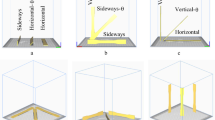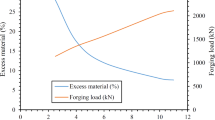Abstract
Tube shear bending is a beneficial technique to realize considerable small bending radii. The authors have investigated the tube shear bending process of circular tubes experimentally. Moreover, an elastoplastic 3D finite element simulation has been conducted, aimed at clarifying the forming mechanism. Both the experiment and simulation results indicate that, in order to perform successful forming, the value of the applied pushing force on the tube must be appropriate. In this paper, the mechanism of defect generation was clarified. Two failure criteria were introduced and employed to recognize the occurrence of defects in the simulation. The effects of the die corner radius, as the main parameter, on the defect generation of circular A1050 aluminum tubes were investigated both by experiments and numerical simulation. From the results, the formability of tube on dies with different corner radii applying various pushing pressures was clarified. Moreover, the influence of the die radius on the dimensional accuracy of the deformed tube regarding cross-section ovality and thickness changes of the deformed tube was evaluated. The results of this study indicate that, whilst a small bending radius results in high cross-section ovality, increasing the die corner radius raises the wrinkling tendency of the tube. However, the die radius has a small effect on the suitable values of pushing pressure required for a successful shear bending deformation. Moreover, the effect of the die corner radius on the thickness strain of the deformed tube is insignificant.
Similar content being viewed by others
References
Lange K (1985) Handbook of metal forming. McGraw-Hill, New York
Tanaka M, Michino M, Sano K, Narita M (1994) Pipe bending technology with zero bending radius. J Jpn Soc Tech Plasticity 35:232 (in Japanese)
Gantner P, Bauer H, Harrison DK, De Silva AKM (2005) Free-Bending—a new bending technique in the hydroforming process chain. J Mat Process Tech 167(2–3):302–308
Tanaka M, Michino M, Fujihira K (1996) Pipe forming using shear deformation. In: Proceedings of the 1996 Japanese Conference on the Technology of Plasticity, 170–171 (in Japanese)
Japan patent no. 210722A (2000)
Hamanishi Y, Kato K (2002) The development of shear bending and Its applications. In: Proceedings of the 99th Japanese Meeting on Tube Forming Technology (in Japanese)
Goodarzi M, Kuboki T, Murata M (2005) Deformation analysis for the shear bending process of circular tubes. J Mat Process Tech 162–16(3):492–497
Goodarzi M, Kuboki T, Murata M (2005) The effect of pushing force on the shear bending process of circular. In: Proceedings of the 8th International Conference on Technology of Plasticity (ICTP 2005), Trieste, Italy, October 2005 (on CD)
Miller G (2003) Tube forming processes—a comprehensive guide. SME, Dearborn, Michigan
Sheng ZQ, Jirathearanat S, Altan T (2004) Adaptive FEM simulation for prediction of variable blank holder force in conical cup drawing. Int J Mach Tool Manu 44(5):487–494
Nordlund P, Haggblad B (1997) Prediction of wrinkle tendencies in explicit sheet metal-forming simulations. Int J Num Meth Eng 40(22):4079–4095
Wang X, Cao J (2001) Wrinkling limit in tube bending. Trans ASME 123(4):430–435
Peek R (2002) Wrinkling of tubes in bending from finite strain three-dimensional continuum theory. Int J Solids Struct 39(3):709–723
Yang H, Lin Y (2004) Wrinkling analysis for forming limit of tube bending processes. J Mat Process Tech 152(3):363–369
Gao L, Strano M (2004) FEM analysis of tube pre-bending and hydroforming. J Mat Process Tech 151(1–3):294–297
Author information
Authors and Affiliations
Corresponding author
Rights and permissions
About this article
Cite this article
Goodarzi, M., Kuboki, T. & Murata, M. Effect of die corner radius on the formability and dimensional accuracy of tube shear bending. Int J Adv Manuf Technol 35, 66–74 (2007). https://doi.org/10.1007/s00170-006-0697-x
Received:
Accepted:
Published:
Issue Date:
DOI: https://doi.org/10.1007/s00170-006-0697-x




